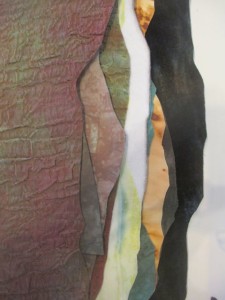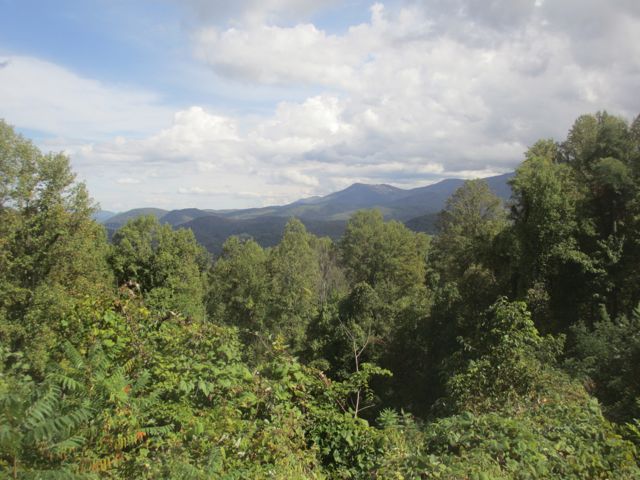
The Great Smoky Mountains National Park
From October 8th to 11th I attended Made/Aware, the Surface Design Association Intensive at Arrowmont School of Arts and Crafts in Gatlinburg, Tennessee, on the edge of the Great Smoky Mountains National Park. Over the course of four days, twelve time slots were filled with over 20 presentation options to hear from makers and curators working in socially engaged practices with textiles. In between these sessions was a reception for Materialities, SDA’s 1st International Juried Members Exhibition (selected images are shown in this post), shared meals, conversations in the hallways, and the opportunity to spend time with the thoughtfully curated exhibition. Intensive was an appropriate title for the experience.

Ori-Kume #45, Susan Cavanaugh, Cloth, stitched and dyed, 2014
As a presenter myself of 10x20x20: Socially Engaged Work by SDA Members, a pecha kucha-style panel (see previous blog post for more information), I really enjoyed feeling a part of the whole. It was a delight to meet the members of the panel in person. Each of them had shared such personal work that it was a pleasure to connect with them.
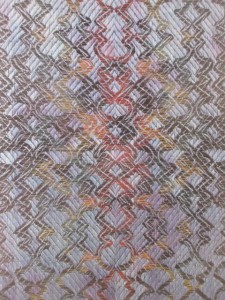
#433 Local Journey: Dawn, Day, Dusk (detail), Janice Lessman-Moss, Linen, paper core, digital jacquard, hand-woven TC2, shifted ikat weft, 2014
Namita Gupta Wiggers, curator of Materialities, opened the Intensive. She spoke of her curatorial process for the exhibition. Over 2000 artworks were entered by over 500 artists for the 91 artists in the catalog and 51 in the exhibition. I was disappointed when I got my rejection notice but once I saw the show I understood that my work didn’t fit. (It helped that there were many of us there, including leaders and mentors, who didn’t get in either.) Namita spoke of her investigating question, “What do textiles/fibers and their associated processes offer artists that cannot be achieved in other media?” The textile works she chose referenced the essential building block of the media, the grid. She also selected those works that then broke the grid and those that address other surfaces than the wall. All of these pieces illustrated the very “materiality” of textiles. Two video pieces illustrated both making, and unmaking, of garments imbued with culture and tradition. Work made with traditional fibers was shown alongside textiles in 2- and 3-dimensions created with metals, fishing net, clothing, paper, feathers, and even a mop. Techniques included weaving, embroidery, sewing, felting, dyeing, painting, and photography, all with a direct connection to the hand.
SDA has published a beautiful catalog of Materialities that includes artist statements, essays, and illustrations of all the works. It’s a valuable survey of some of what is happening internationally in fibers. I enjoyed looking at the work with the other artists, often trying to puzzle out how it was made. We fiber people are curious sorts, I think a result of the process-driven investigations that are inherent in our practices. I wonder if there are any other media that are as broad in materials and technique as fibers?

Materialities, Letters from Broadway, Judith Plotner, Fiber/Mixed Media, 2014
Friday morning began with a moving and motivating talk by Mary Fisher, artist and HIV/AIDS activist, whose passion for art and activism are intertwined. She rejects the idea of being a victim of disease, stating that illness is just a part of life like motherhood or caring for the elderly. She drew a comparison between the bravery of living with disease to that required to be an artist and encouraged us to look beyond self-interest and self-promotion and use, “what is holy in us to help others.”
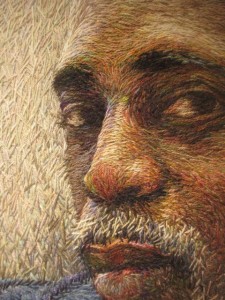
Materialities, The Impossible Dream is the Gateway to Self-Love (detail), Ruth Miller, Hand-stitched embroidery, wool on jute cotton fabric, 2013
Fisher’s talk became a touchstone for the Intensive, giving attendees a way in, a way of seeing themselves in solutions. She spoke of her current work developing the 100 Good Deed Bracelet which both supports small business for women in Africa and encourages people to anonymously go out of their way to help others. It may seem odd, but I thought of Burning Man and how the ethos of gifting is one of the 10 Principles of the event. Although perceived by many to be a hedonistic party in the desert (it is that, too), it was founded to be a model of a different society where a gift is a helping hand as often as a consumable object.
Friday afternoon’s session was co-led by Namita and Rowland Ricketts, a professor at Indiana University. In this session they took us out of the passive role of sitting and listening and into an active role, writing, responding, and moving in a meditative silent exercise. Although I think it would have been more successful in a smaller gathering, I appreciated the chance to step literally outside of the box. The participants seemed willing participants and for me, the writing was a fertile beginning to a longer writing about personal process.

Materialities, Variance 1, Mary Babcock, Reclaimed gillnets, nautical maps, deep sea leader line, 2011
Other speakers included Laura Sansone talking about the Textile Lab, a project where she and her students bring natural fibers and dyeing to their local Farmer’s Market and introduce the community to processing and dyeing wool with the plant materials found there at the market. Carole Frances Lung, aka Frau Fiber, talked of her radical performative actions designed to educate people about where their clothing comes from and the our unsustainable system of “Fast Fashion.” Rowland Ricketts took us along on his personal journey and fascination with indigo.
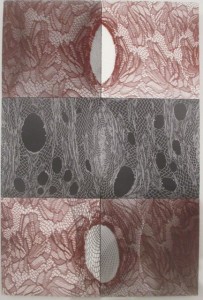
Materialities, Transformation, Joyce Watkins King, Acrylic and stockings on cradled board, 2014
Ann Morton led a breakout session on socially engaged art. Her work with the homeless population of Phoenix, Arizona is both accessible and conceptual. She avoids the taint of the “do-gooder” by observation and listening, understanding and speaking to homeless individuals and their experience, while creating installations that are undeniably art. After her presentation, Ann led a successful group conversation about the difference between “socially engaged practices” and “social work.” It was highly participatory and good to hear the opinions of those in the room.
10x20x20 was Saturday afternoon and was a huge success. All ten presenters did a fantastic job and received a well-deserved standing O. I loved hearing their stories after all the time I had spent looking at their images. It was a huge pleasure (and relief) that it fulfilled all of the hopes I had for it, connecting members and allowing for deeper conversations. I received many compliments on putting it together and was asked by the Board to repeat the panel at future conferences.
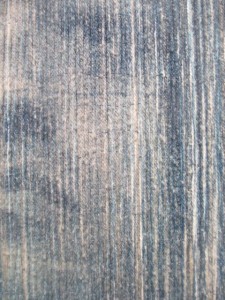
Materialities, Self Portrait (detail), Howard Ptaszek, Cyanotype on mop, and yarn, 2014
The weekend’s sessions were closed by Charlotte Kwon of Maiwa Handprints, a Canadian company that works with native artisans in India to produce hand-made textiles for the western market. Her work in India has supported the resurgence of native craft and use of natural dyes. Her presentation was very inspiring. The scope of what she has supported is enormous. Through Maiwa, her vision and determination has bridged gaps between western and eastern culture and provided income to native populations that has allowed these unique arts to survive in the modern world.
Overall, the excellent programming and the intimate setting of this Intensive made it well worthwhile to fly across the country for a long weekend. Personally, I would have enjoyed broadening the topic beyond natural dyeing to include ways to use synthetic dyes in a more environmentally responsible way. There is more to reforming the global fashion industry than boiling up carrot tops and many of the presenters spoke to the fact that their practices are not scaleable to a larger industry, at least not yet.
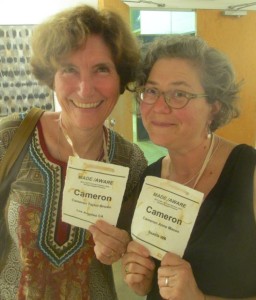
meeting my doppelganger!
But I truly enjoyed it and hope that SDA continues to present these smaller, more focused Intensives. As I wrote on my Facebook page on Saturday night after a couple of margaritas with new friends, “I’ve had such an amazing and thought-provoking time at the Surface Design Assoc. Intensive at Arrowmont in Tennessee. If you are an artist working in textile materials then these are your people.” After time to digest this full feast of inspiration, and fully sober, I would say the same thing.

